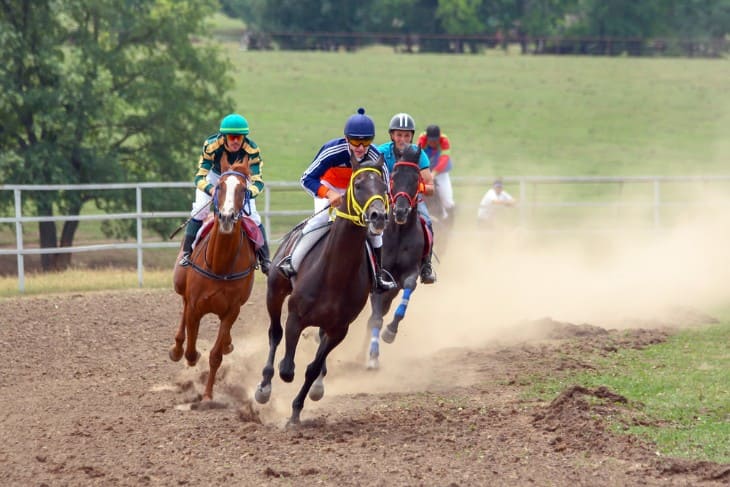What is Overround in Horse Racing?
Some call it overround. Others call it vig, which is short of vigorish, while some simply call it margin. Still, no matter the name, it denotes one of the fundamental aspects of horse racing. Specifically, it is the embedded profit bookmakers take from the odds they introduce. In other words, that is a principle guaranteeing bookies a steady profit, irrespective of the race’s outcome.
Therefore, what is overround in horse racing and why is it of such prominence? These answers we are looking for today. I will help you understand how it works better, to be aware of the fact that it brings transparency that allows bettors to be sure about the fairness these odds bring.
How to Understand the Relationship between Odds and Probability
Thus, it is the primary head for every bettor to comprehend the connection between bookmakers’ odds and probability. In brief, the odds indicate how probable a bookie views an outcome to be. The lower the odds, the higher bookie values the percentage of specific outcomes happening. The higher the odds, the less the bookie thinks the outcome has a chance; therefore, it becomes more lucrative for the bettor. It is the essential way for bettors to determine their chances for success, calculate implied odds and compare them with their own predictions.
Overround vs. Probability: How Bookmakers Ensure Profit
No matter the outcome, bookmakers are there to make a profit. That’s why bookmakers always set the odds in a way to ensure total implied probabilities of all outcomes exceed 100%. In other words, when there are 3 horses in a race, each with 2/1 odds, the total implied probability is 99.9%. So, what they do is create an overround. That’s achieved by adjusting the odds slightly. These adjustments are minimal but they ensure that the total probability goes over 100%. So, no matter the outcome, the bookmaker makes a profit in the long term.
Importance of Overround in Bookmakers' Pricing Strategy
All in all, it’s pretty easy to conclude that this is the most essential element of a bookmaker’s pricing strategy. They are setting odds to create a slight overround, and ensuring that the profit margin remains adequate.
All in all, it’s essential to keep the overround balanced, to offer competitive odds but secure profit margins. In that way, bettors are ensuring both a sustainable business model and fairness of their odds.

Impact of Overround on Betting Payouts
How Overround Affects Potential Payouts to Bettors
Things are pretty simple here. Overround directly determines the potential payout to a bettor. With minimal adjustments, the odds offered to bettors are a tiny bit smaller than they would be in the case of naturally represented odds, based on true probabilities. In essence, bettors will receive slightly less money compared to the risk they are taking but once again, it’s all about finding the right balance and maintaining fairness.
Comparing Overround Across Different Bookmakers
Each bookmaker has its own business model when it comes to overround. For that reason, the odds usually differentiate from bookie to bookie but in most cases, these differences are minimal. In any case, bettors can compare the overround offered by different bookies and identify the most favourable odds. Simply said, bookmakers with lower overrounds offer better value, because their odds are closer to true probability. So, this comparison gives bettors a chance to choose the bookmaker with the most competitive odds and maximise their potential payouts.
Real-Life Examples of Overround and Its Consequences for Punters
Once again, let’s take a 3-horse race as an example. Bookmaker X offers the following odds:
- Horse A: 2/1 (implied probability: 33.33%)
- Horse B: 3/1 (implied probability: 25%)
- Horse C: 4/1 (implied probability: 20%)
The total implied probability without the overround is 78.33%. However, Bookmaker X adjusts the odds to include a 5% overround, making the total implied probability 83.33%. If a bettor places a $100 bet on Horse A and wins, the payout should ideally be $200 (including the stake). Due to the overround, the actual payout would be slightly less, diminishing the bettor's potential profits.
Overround and Competitive Betting Markets
Undoubtedly, with the amount of both online and brick-and-mortar organisations, the mark of horse racing bears all signs of being highly competitive. Thus, such a bookmaker must exhibit a profound strategical use of overround in the manner, which enables to attract bettors with sweetest odds and simultaneously stay within yield. To do that, it accounts for so many factors, including those mentioned above, bettors’ choices, recent accidents, horse forms etc.
In that way, bookmakers can handle fluctuations in betting volumes and market demands. By adjusting the odds and overround in response to market dynamics, they can also find a perfect balance between enticing bettors and securing their profit margins.
Strategies for Punters to Mitigate the Impact of Overround
- Compare odds from different bookmakers: Punters could compare odds from various bookmakers and choose the lowest overround, which allows bettors to have a higher golden nugget available. Punters can bet with decent vacancies by implying strong chances with lower odds from the capital they are betting.
- Value betting: Punters can use implied probabilities from odds and compare their implied probabilities and actual thoughts of the possibility of the happening of the event. If a punter believes the possibilities for an event to happen are more than the implied probabilities from bookmakers, then the punter might assume the happening may be a value bet for this fan of matches.
- Betting exchanges: Instead of betting against the bookmaker, punters bet against other punters through bookmakers. There is no traditional overround in this gambling section, and the odds are rather supply and demand. These are other options punters might have, but the disadvantage is the bettor facing overround is different from multiple bookies.
Overround in Horse Racing: Challenges and Controversies
As you may presume, overround and the concept of fairness are a topic of ongoing debate. There are different stances on this, but the general thought is that bookmakers sometimes use overround too much to cover things like operational costs, manage rates and ensure overall sustainability. The problem is that most think that over rounds are way too high and that they impact bettors’ potential payouts more than they should. In other words, bettors cannot achieve the profit they deserve. It’s an ever-lasting debate on the balance between bookmakers’ profitability and fair betting opportunities for punters.
Transparency Issues and Regulatory Measures
An important aspect of overround is the need for transparency in horse racing and betting in general. This demands that bettors have access to current and precise information regarding the odds and the overround percentage for them to make well-informed decisions. Regulatory authorities have mandated the need for transparency and fairness in the industry. Some countries have regulations that require bookmakers to show the percentage markup on the odds, thus bettors can determine whether the offered odds are favourable or not. Other measures target ensuring there is no deception and a level playing field among bookmakers.
Ethical Implications of Overround in the Gambling Industry
Ethical concerns about overround primarily focus on the possibility of exploiting vulnerable consumers, notably problem gamblers. Overround rates that are too high may increase the risk of harm to consumers by ensuring that bettors suffer significant financial losses. Advocates of responsible gambling insist that the measures to improve professional ethics should include the requirement to disclose overround information with honesty, raise awareness about the role of this phenomenon in influencing potential winnings, and provide assistance to consumers who are already struggling with gambling addiction.
Today, bookmakers and regulatory authorities are expected to resolve such concerns more often, as the industry’s reputation becomes more of a focus in terms of consumer welfare protection. The discussed issues and controversies around overround highlight the importance of ongoing dialogue between stakeholders, such as consumers, bookmakers, responsible gambling professionals, and enforcement agencies. Ensuring that the bookmaker industry remains profitable while protecting consumer rights is the key to the horse racing industry’s long-term ethical character.

Overround and Horse Racing Enthusiasts
Understanding overround empowers horse racing enthusiasts by providing them with the tools to make informed betting decisions. With information about overround, horse racing followers can rely on more valuable assessments of the odds they are getting from bookies. Likewise, an awareness of overround allows fans to grasp objectives on which they can bet. Finally, overround helps avoid making wagers with sub-optimal returns or unprofitable ones. Horse racing fans can use these insights to make more deliberate betting choices, improve their overall experience, and potentially improve their profitable betting activity.
Tips for Evaluating Odds and Overround Before Placing Bets
- Compare Odds Across Multiple Bookmakers: To get an idea of what values are acceptable when betting on horse racing, enthusiasts should begin by comparing the odds and overround percentages across bookmakers. By doing so, they can determine which bookmakers’ bets are overcharged, allowing them to look for those who maintain low overrounds.
- Calculate Implied Probabilities: Starting from the odds, fans can also calculate the implied probabilities and then compare them to their assessments. If calculated probabilities are much lower than those made by enthusiasts, they can rethink their bets because quotes were unfavourable for them.
- Consider Betting Exchanges: Quotes by bookmakers are too high, the same can be said for overrounds. The best way to avoid the confirmed ineffective overround is betting exchanges, for their overround percentage is much lower compared to regular bookmakers.
Understanding the Risks: Responsible Gambling in Light of Overround
Lastly, responsible gambling should be emphasised to understand the overround. Enthusiasts ought to be cautious of the dangers linked to betting; this is how overround is connected to prospective losses. Therefore, this principle necessitates that fans establish a budget, limit wagering amounts, and avoid loss aversion. However, by comprehending the overround, fans might determine if the odds are fair and settle their betting patterns, hence lowering the dangers connected with the figures. When it comes to horse racing, gambling should be approached as entertainment and not a money-making endeavour. Enthusiasts may merge their overround understanding into a more comprehensive perspective of what responsible gambling entails. In this way, fans can engage in the thrill of horse betting whilst minimising the financial hazard.
Summary
I hope you found my answer decent to the “what is overround in horse racing” question. The above argumentation implies that understanding overround is essential for both dedicated horse racing fans and bettors. It is a key, a basic entry-level element allowing you to better navigate the world of betting odds, teaching you to make informed, intentional bets in a highly competitive environment. At the same time, such knowledge entails certain responsibilities. Enthusiasts should exercise caution when betting, understanding the risks, and sticking to measures like setting limits, comparing multiple betting odds effects, and considering overround impacts. Finally, the history of overround, its correlation with other controversial issues, the challenges and criticisms it faces underline the need for the industry for more responsible and balanced behaviour. It can be achieved if all stakeholders – from operators and regulatory bodies to horse racing fans – acknowledge the potential benefits and respond with proactive cooperation.
For more information:








